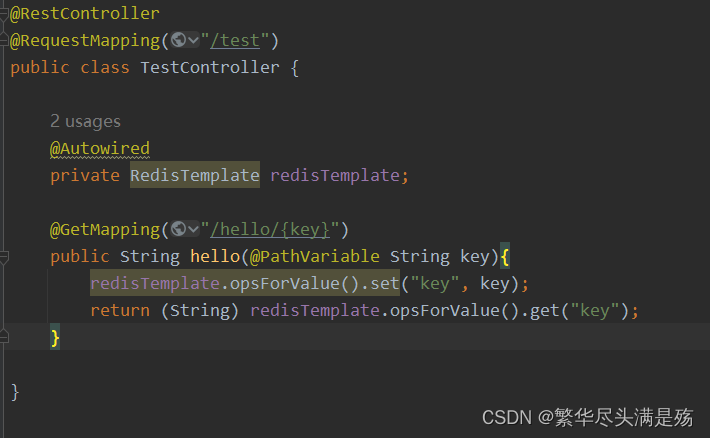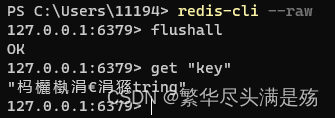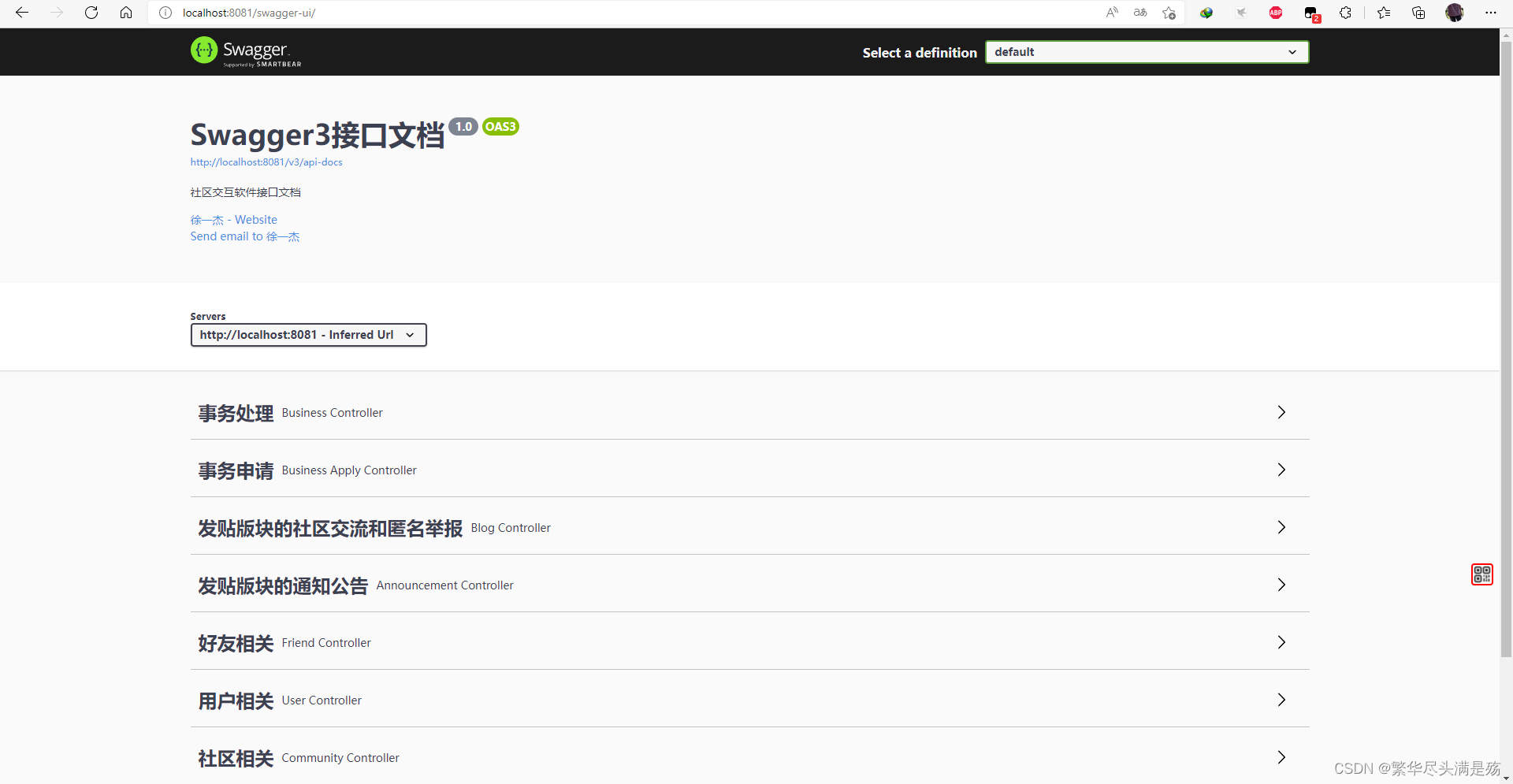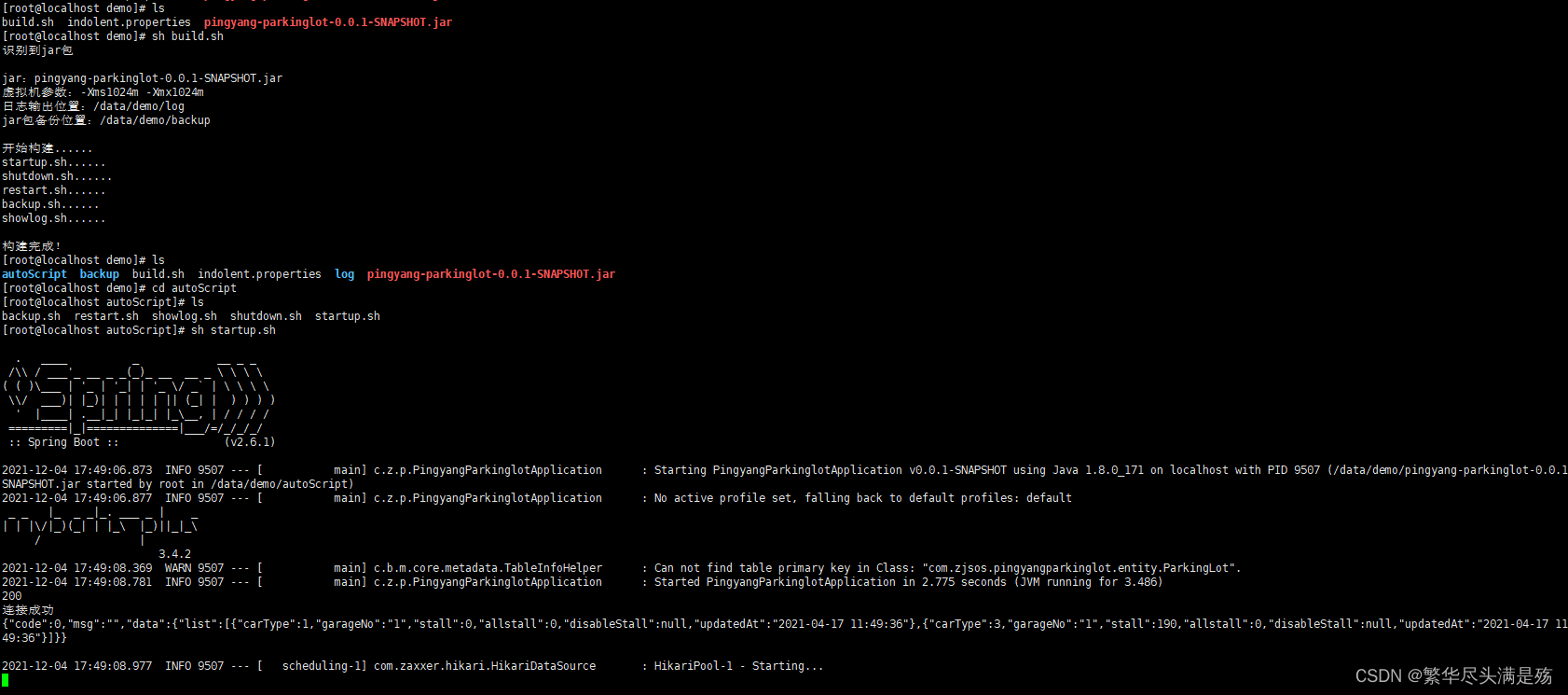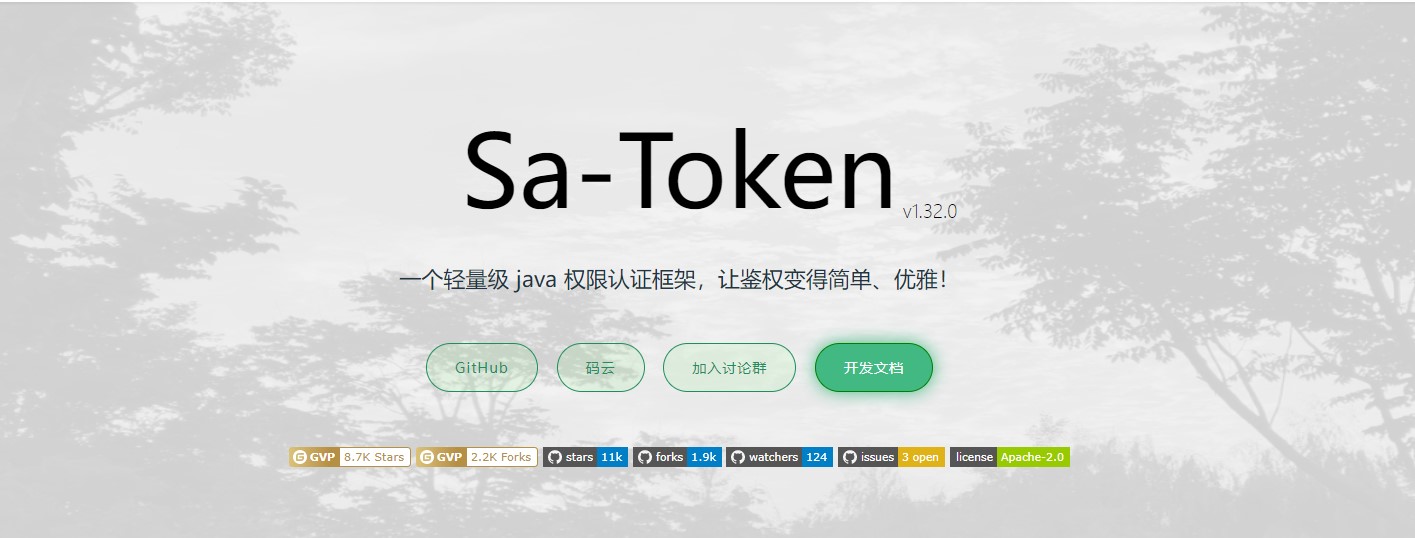Springboot 使用 Redis 并配置序列化和封装 RedisTemplate
前言
为什么要配置序列化:如果不配置序列化的话,我们在redis数据库中存储的数据可能以乱码形式显示出来,不方便我们判断数据存储的正确性,说白了就是序列化以后存进去的是什么,查询出来的就是什么,否则我们的键值都会变成一串看不懂的乱码。
为什么要封装RedisTemplate,因为如果不进行封装的话,大家请看,是不是有黄色的警告信息,看着起来很不舒服,RedisTemplate后面的尖括号可以填泛型,填写以后警告就消失了,但我们的类型很多,每次只能Autowired一个RedisTemplate,所以不能写尖括号内的类型,同时封装也能按照自己的习惯自定义方法,更好用。
一、引入依赖
只需要引入这一个就可以了,现在的版本里面包含了 lettuce ,所以不需要再额外引入 common-pool2
1 | <dependency> |
二、配置yml
因为我使用的是Springboot 3.0,所以配置层级是 spring-data-redis,如果你们的配置文件爆红,说明你们是旧版,那么把data去掉就可以了,直接是 spring-redis
1 | server: |
三、RedisConfig 配置序列化
1 | package pers.xuyijie.communityinteractionsystem.config; |
四、封装RedisTemplate
注意,我这里用的是 Java17 新增的 record 纪录类,如果你们是低版本的 JDK ,把 record 更换成 class ,然后注入RedisTemplate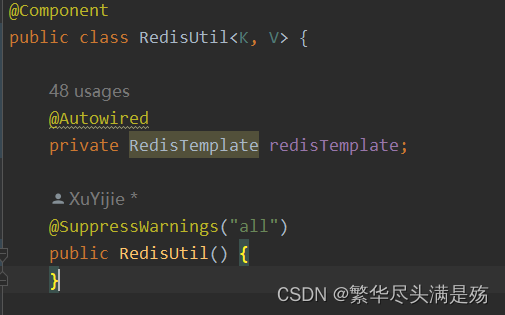
https://qiniuoss.xuyijie.icu/XuYijieBlog/BlogImage/RedisSerilize0.png;
import org.springframework.data.redis.core.*;
import org.springframework.stereotype.Component;
import java.util.Collection;
import java.util.List;
import java.util.Map;
import java.util.Set;
import java.util.concurrent.TimeUnit;
/**
@author: 徐一杰
@date: 2022/4/3
@description: 对RedisTemplate进行封装
*/
@Component
@SuppressWarnings({“unchecked”, “rawtypes”, “ConstantConditions”})
public record RedisUtil<K, V>(RedisTemplate<K, V> redisTemplate) {public RedisUtil {
}
/**
- 默认存活时间 2 天
*/
private static final long DEFAULT_EXPIRE_TIME = 60 * 60 * 48;
/**
- 根据key 获取过期时间
- @param key 键 不能为null
- @return 时间(秒) 返回0代表为永久有效
*/
public long getExpireTime(K key) {
return redisTemplate.getExpire(key, TimeUnit.SECONDS);
}
/**
- 指定缓存失效时间
- @param key 键
- @param expireTime 时间(秒)
*/
public void setExpireTime(K key, long expireTime) {
try {
if (expireTime > 0) {
redisTemplate.expire(key, expireTime, TimeUnit.SECONDS);
}
} catch (Exception e) {
e.printStackTrace();
}
}
/**
- 移除指定 key 的过期时间
- @param key 键
*/
public void removeExpireTime(K key) {
redisTemplate.boundValueOps(key).persist();
}
/**
- 获取缓存中所有的键
- @param key 键
- @return 缓存中所有的键
*/
public Setkeys(K key) {
return redisTemplate.keys(key);
}
/**
- 判断key是否存在
- @param key 键
- @return true 存在 false不存在
*/
public boolean hasKey(K key) {
try {
return Boolean.TRUE.equals(redisTemplate.hasKey(key));
} catch (Exception e) {
e.printStackTrace();
return false;
}
}
/**
- 根据key删除缓
- @param keys 键
*/
public void delete(Collectionkeys) {
redisTemplate.delete(keys);
}
/**
- 设置分布式锁
- @param key 键,可以用用户主键
- @param value 值,可以传requestId,可以保证锁不会被其他请求释放,增加可靠性
- @param expire 锁的时间(秒)
- @return 设置成功为 true
*/
public Boolean setNx(K key, V value, long expire) {
return redisTemplate.opsForValue().setIfAbsent(key, value, expire, TimeUnit.SECONDS);
}
/**
- 设置分布式锁,有等待时间
- @param key 键,可以用用户主键
- @param value 值,可以传requestId,可以保证锁不会被其他请求释放,增加可靠性
- @param expire 锁的时间(秒)
- @param timeout 在timeout时间内仍未获取到锁,则获取失败
- @return 设置成功为 true
*/
public Boolean setNx(K key, V value, long expire, long timeout) {
long start = System.currentTimeMillis();
//在一定时间内获取锁,超时则返回错误
for (; ; ) {
// 获取到锁,并设置过期时间返回true
boolean acquire = redisTemplate.opsForValue().setIfAbsent(key, value, expire, TimeUnit.SECONDS);
if (acquire) {
return true;
}
//否则循环等待,在timeout时间内仍未获取到锁,则获取失败
if (System.currentTimeMillis() - start > timeout) {
return false;
}
}
}
/**
- 释放分布式锁
- @param key 锁
- @param value 值,可以传requestId,可以保证锁不会被其他请求释放,增加可靠性
- @return 成功返回true, 失败返回false
*/
public boolean releaseNx(K key, V value) {
Object currentValue = redisTemplate.opsForValue().get(key);
boolean result = false;
if (String.valueOf(currentValue) != null && currentValue.equals(value)) {
result = redisTemplate.opsForValue().getOperations().delete(key);
}
return result;
}
/*********** String 类型操作 **************/
/**- 普通缓存放入
- @param key 键
- @param value 值
*/
public void set(K key, V value) {
try {
redisTemplate.opsForValue().set(key, value);
} catch (Exception e) {
e.printStackTrace();
}
}
/**
- 普通缓存放入并设置时间
- @param key 键
- @param value 值
- @param time 时间(秒) time要大于0 如果time小于等于0 将设置无限期
*/
public void set(K key, V value, long time) {
try {
if (time > 0) {
redisTemplate.opsForValue().set(key, value, time, TimeUnit.SECONDS);
} else {
redisTemplate.opsForValue().set(key, value);
}
} catch (Exception e) {
e.printStackTrace();
}
}
/**
- value增加值
- @param key 键
- @param number 增加的值
- @return 返回增加后的值
*/
public Long incrBy(String key, long number) {
return (Long) redisTemplate.execute((RedisCallback) connection -> connection.incrBy(key.getBytes(), number));
}
/**
- value减少值
- @param key 键
- @param number 减少的值
- @return 返回减少后的值
*/
public Long decrBy(String key, long number) {
return (Long) redisTemplate.execute((RedisCallback) connection -> connection.decrBy(key.getBytes(), number));
}
/**
- 根据key获取value
- @param key 键
- @return 返回值
*/
public V get(K key) {
BoundValueOperations<K, V> boundValueOperations = redisTemplate.boundValueOps(key);
return boundValueOperations.get();
}
/*********** list 类型操作 **************/
/**
- 将value从右边放入缓存
- @param key 键
- @param value 值
*/
public void listRightPush(K key, V value) {
ListOperations<K, V> listOperations = redisTemplate.opsForList();
//从队列右插入
listOperations.rightPush(key, value);
}
/**
- 将value从左边放入缓存
- @param key 键
- @param value 值
*/
public void listLeftPush(K key, V value) {
ListOperations<K, V> listOperations = redisTemplate.opsForList();
//从队列右插入
listOperations.leftPush(key, value);
}
/**
- 将list从右边放入缓存
- @param key 键
- @param value 值
*/
public void listRightPushAll(K key, Listvalue) {
try {
redisTemplate.opsForList().rightPushAll(key, value);
} catch (Exception e) {
e.printStackTrace();
}
}
/**
- 将list从左边放入缓存
- @param key 键
- @param value 值
*/
public void listLeftPushAll(K key, Listvalue) {
try {
redisTemplate.opsForList().leftPushAll(key, value);
} catch (Exception e) {
e.printStackTrace();
}
}
/**
- 通过索引 获取list中的值
- @param key 键
- @param index 索引 index>=0时, 0 表头,1 第二个元素,依次类推;index<0时,-1,表尾,-2倒数第二个元素,依次类推
- @return 返回列表中的值
*/
public V listGetWithIndex(K key, long index) {
try {
return redisTemplate.opsForList().index(key, index);
} catch (Exception e) {
e.printStackTrace();
return null;
}
}
/**
- 从list左边弹出一条数据
- @param key 键
- @return 队列中的值
*/
public V listLeftPop(K key) {
ListOperations<K, V> listOperations = redisTemplate.opsForList();
return listOperations.leftPop(key);
}
/**
- 从list左边定时弹出一条
- @param key 键
- @param timeout 弹出时间
- @param unit 时间单位
- @return 队列中的值
*/
public V listLeftPop(K key, long timeout, TimeUnit unit) {
ListOperations<K, V> listOperations = redisTemplate.opsForList();
return listOperations.leftPop(key, timeout, unit);
}
/**
- 从list右边弹出一条数据
- @param key 键
- @return 队列中的值
*/
public V listRightPop(K key) {
ListOperations<K, V> listOperations = redisTemplate.opsForList();
return listOperations.rightPop(key);
}
/**
- 从list左边定时弹出
- @param key 键
- @param timeout 弹出时间
- @param unit 时间单位
- @return 队列中的值
*/
public V listRightPop(K key, long timeout, TimeUnit unit) {
ListOperations<K, V> listOperations = redisTemplate.opsForList();
return listOperations.leftPop(key, timeout, unit);
}
/**
- 获取list缓存的内容
- @param key 键
- @param start 开始下标
- @param end 结束下标 0 到 -1 代表所有值
- @return list内容
*/
public ListlistRange(K key, long start, long end) {
try {
ListOperations<K, V> listOperations = redisTemplate.opsForList();
return listOperations.range(key, start, end);
} catch (Exception e) {
e.printStackTrace();
return null;
}
}
/**
- 获取list缓存的长度
- @param key 键
- @return list长度
*/
public long listSize(K key) {
try {
return redisTemplate.opsForList().size(key);
} catch (Exception e) {
e.printStackTrace();
return 0;
}
}
/**
- 根据索引修改list中的某条数据
- @param key 键
- @param index 下标
- @param value 值
*/
public void listSet(K key, long index, V value) {
try {
redisTemplate.opsForList().set(key, index, value);
} catch (Exception e) {
e.printStackTrace();
}
}
/**
- 从lit中移除N个值为value的值
- @param key 键
- @param count 移除多少个
- @param value 值
- @return 移除的个数
*/
public long listRemove(K key, long count, V value) {
try {
return redisTemplate.opsForList().remove(key, count, value);
} catch (Exception e) {
e.printStackTrace();
return 0;
}
}
/*********** hash 类型操作 **************/
/**
- 根据key和键获取value
- @param key 键 不能为null
- @param item 项 不能为null
- @return 值
*/
public <HK, HV> HV hashGet(K key, String item) {
HashOperations<K, HK, HV> hashOperations = redisTemplate.opsForHash();
return hashOperations.get(key, item);
}
/**
- 获取key对应的所有键值
- @param key 键
- @return 对应的多个键值
*/
public <HK, HV> Map<HK, HV> hashMGet(K key) {
HashOperations<K, HK, HV> hashOperations = redisTemplate.opsForHash();
return hashOperations.entries(key);
}
/**
- 添加map到hash中
- @param key 键
- @param map 对应多个键值
*/
public void hashMSet(K key, Map<String, Object> map) {
try {
redisTemplate.opsForHash().putAll(key, map);
} catch (Exception e) {
e.printStackTrace();
}
}
/**
- 添加map到hash中,并设置过期时间
- @param key 键
- @param map 对应多个键值
- @param expireTime 时间(秒)
*/
public void hashMSet(K key, Map<String, Object> map, long expireTime) {
try {
redisTemplate.opsForHash().putAll(key, map);
if (expireTime > 0) {
redisTemplate.expire(key, expireTime, TimeUnit.SECONDS);
}
} catch (Exception e) {
e.printStackTrace();
}
}
/**
- 向hash表中放入一个数据
- @param key 键
- @param hKey map 的键
- @param value 值
*/
public <HK, HV> void hashPut(K key, HK hKey, HV value) {
try {
HashOperations<K, HK, HV> hashOperations = redisTemplate.opsForHash();
hashOperations.put(key, hKey, value);
} catch (Exception e) {
e.printStackTrace();
}
}
/**
- 向hash表中放入一个数据,并设置过期时间
- @param key 键
- @param hKey map 的键
- @param value 值
- @param expireTime 时间(秒) 注意:如果已存在的hash表有时间,这里将会替换原有的时间
*/
public <HK, HV> void hashPut(K key, HK hKey, HV value, long expireTime) {
try {
redisTemplate.opsForHash().put(key, hKey, value);
if (expireTime > 0) {
redisTemplate.expire(key, expireTime, TimeUnit.SECONDS);
}
} catch (Exception e) {
e.printStackTrace();
}
}
/**
- 判断hash表中是否有该项的值
- @param key 键 不能为null
- @param hKey map 的键 不能为null
- @return true 存在 false不存在
*/
public <HK, HV> boolean hashHasKey(K key, HK hKey) {
HashOperations<K, HK, HV> hashOperations = redisTemplate.opsForHash();
return hashOperations.hasKey(key, hKey);
}
/**
- 取出所有 value
- @param key 键
- @return map 中所有值
*/
public <HK, HV> ListhashValues(K key) {
HashOperations<K, HK, HV> hashOperations = redisTemplate.opsForHash();
return hashOperations.values(key);
}
/**
- 取出所有 hKey
- @param key 键
- @return map 所有的键
*/
public <HK, HV> SethashHKeys(K key) {
HashOperations<K, HK, HV> hashOperations = redisTemplate.opsForHash();
return hashOperations.keys(key);
}
/**
- 删除hash表中的键值,并返回删除个数
- @param key 键
- @param hashKeys 要删除的值的键
- @return 删除个数
*/
public <HK, HV> Long hashDelete(K key, Object… hashKeys) {
HashOperations<K, HK, HV> hashOperations = redisTemplate.opsForHash();
return hashOperations.delete(key, hashKeys);
}
/*********** set 类型操作 **************/
/**- 将数据放入set缓存
- @param key 键
- @param values 值 可以是多个
*/
public void setAdd(K key, V… values) {
redisTemplate.opsForSet().add(key, values);
}
/**
- 将set数据放入缓存,并设置过期时间
- @param key 键
- @param expireTime 时间(秒)
- @param values 值 可以是多个
*/
public void setAdd(K key, long expireTime, V… values) {
redisTemplate.opsForSet().add(key, values);
if (expireTime > 0) {
redisTemplate.expire(key, expireTime, TimeUnit.SECONDS);
}
}
/**
- 获取set缓存的长度
- @param key 键
- @return set缓存的长度
*/
public long setSize(K key) {
try {
return redisTemplate.opsForSet().size(key);
} catch (Exception e) {
e.printStackTrace();
return 0;
}
}
/**
- 根据key获取Set中的所有值
- @param key 键
- @return Set中的所有值
*/
public SetsetValues(K key) {
SetOperations<K, V> setOperations = redisTemplate.opsForSet();
return setOperations.members(key);
}
/**
- 根据value从一个set中查询,是否存在
- @param key 键
- @param value 要查询的值
- @return true 存在 false不存在
*/
public boolean setHasKey(K key, V value) {
return Boolean.TRUE.equals(redisTemplate.opsForSet().isMember(key, value));
}
/**
- 根据value删除,并返回删除的个数
- @param key 键
- @param value 要删除的值
- @return 删除的个数
*/
public Long setDelete(K key, Object… value) {
SetOperations<K, V> setOperations = redisTemplate.opsForSet();
return setOperations.remove(key, value);
}
/*********** zset 类型操作 **************/
/**- 在 zset中插入一条数据
- @param key 键
- @param value 要插入的值
- @param score 设置分数
*/
public void zSetAdd(K key, V value, long score) {
ZSetOperations<K, V> zSetOperations = redisTemplate.opsForZSet();
zSetOperations.add(key, value, score);
}
/**
- 得到分数在 score1,score2 之间的值
- @param key 键
- @param score1 起始分数
- @param score2 终止分数
- @return 范围内所有值
*/
public SetzSetValuesRange(K key, long score1, long score2) {
ZSetOperations<K, V> zSetOperations = redisTemplate.opsForZSet();
return zSetOperations.range(key, score1, score2);
}
/**
- 根据value删除,并返回删除个数
- @param key 键
- @param value 要删除的值,可传入多个
- @return 删除个数
*/
public Long zSetDeleteByValue(K key, Object… value) {
ZSetOperations<K, V> zSetOperations = redisTemplate.opsForZSet();
return zSetOperations.remove(key, value);
}
/**
- 根据下标范围删除,并返回删除个数
- @param key 键
- @param size1 起始下标
- @param size2 结束下标
- @return 删除个数
*/
public Long zSetDeleteRange(K key, long size1, long size2) {
ZSetOperations<K, V> zSetOperations = redisTemplate.opsForZSet();
return zSetOperations.removeRange(key, size1, size2);
}
/**
- 删除分数区间内元素,并返回删除个数
- @param key 键
- @param score1 起始分数
- @param score2 终止分数
- @return 删除个数
*/
public Long zSetDeleteByScore(K key, long score1, long score2) {
ZSetOperations<K, V> zSetOperations = redisTemplate.opsForZSet();
return zSetOperations.removeRangeByScore(key, score1, score2);
}
- 默认存活时间 2 天
}
1 |
|
六、操作演示
我们先来演示一下第二个方法,直接浏览器请求,可以看到,存入并查询出了我们存入的数据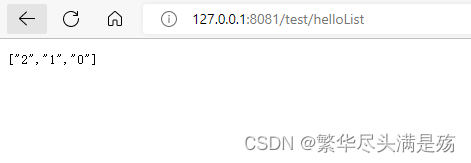
redis控制台也能查询出来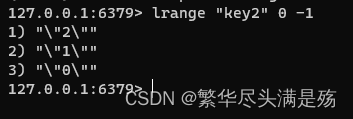
为什么先演示第二个方法呢,因为要用第一个向你们展示一个“小错误”,我们输入中文来测试一下
很棒,成功存入并正确读取出来了对不对
那我们去控制台看一看,注意看,我们的键还是“key”,没有乱码,value的前半部分中文乱码,后面的String是正常显示的,说明这不是序列化的问题
解决方案是,使用 redis-cli –raw 进入控制台,flushall 先清空数据,再次请求接口存储数据,查询出来的中文就出来了,但是我们还是看不懂,这和代码和redis没有关系
原因是电脑的 cmd 字符默认是 GBK,你们bing一下,看看怎么把cmd改为 UTF-8,好像要从注册表里面改,改好就可以正确显示了
其实代码可以正确读取出来就说明一切正常的了,我们控制台看到乱码不必理会,这里只是提一下


